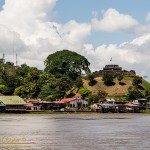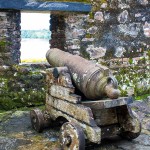The Río San Juan was once critical to the entire region, the river was the main route of access to the entire country. Wide and navigable the river allowed hundreds of miles of thick tropical jungle to be easily transited. People and cargoes could be shipped from the Caribbean to the enormous Lake Nicaragua and the rich farmlands of central Nicaragua. Together the river and lake offered an easy crossing of the isthmus, allowing passengers and cargo to pass between the Atlantic and Pacific Oceans. At the northern end of Lake Nicaragua is Grenada, this old colonial city was the crown jewel of the region, where the treasures of the New World were amassed before shipment to Spain.

Somehow the name Fortress of the Immaculate Conception just does not bring to mind any form of military installation. Despite the name, this fortress is an impressive fortification, easily equivalent to the best contemporary fortifications elsewhere, quite a surprise as the location is and was quite remote. Most photographs fail to convey this, much of the fortress walls are concealed by a surrounding ditch making it difficult to appreciate the fortress without a visit in person. Setting the walls low like this was an important feature of fortifications built during the age of cannon, making the walls a difficult target for attacking gunners. The defenses are well laid out, clearly the work of an experienced military architect. The bastions are properly angled to deflect incoming artillery rounds, gun-ports are positioned to sweep the walls of attacking infantry. Taking this position from prepared defenders would be a difficult proposition indeed.

During a later expedition the British did capture the fortress in 1780, occupying it for eight months and finally abandoning it in early 1781. Among the officers who led this attack was the 22 year old Captain Horatio Nelson, in command of the HMS Hinchinbrook.

Entry to the fort is currently C$50 ($1.80 US in 2015) with an extra C$25 for a photography permit. The decent little museum offers a concise history of the fort and the region, from pre-Columbian to the Vanderbuilt steamships that operated up the river and across the lake. While the main displays are in Spanish a smaller English translation is posted beside each display. You might also bring your bird book and binoculars as the trees around the fort are alive with local birds. Take your time here, learning the history, enjoying the view, or simply watching the vultures soaring in the updrafts around the fortress walls.

